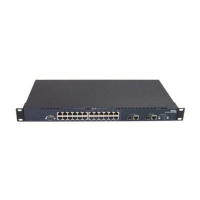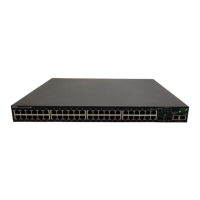346 BigIron RX Series Configuration Guide
53-1002253-01
PVST/PVST+ compatibility
12
These commands configure a VLAN group containing VLANs 2, 3, and 4, add port 1/1 as a tagged
port to the VLANs, and enable the dual-mode feature and PVST+ support on the port. The
dual-mode feature allows the port to send and receive untagged frames for the default VLAN (VLAN
1 in this case) in addition to tagged frames for VLANs 2, 3, and 4. Enabling the PVST+ support
ensures that the port is ready to send and receive PVST+ BPDUs. If you do not manually enable
PVST+ support, the support is not enabled until the port receives a PVST+ BPDU.
The configuration leaves the default VLAN and the port’s native VLAN unchanged. The default
VLAN is 1 and the port’s Port Native VLAN also is 1. The dual-mode feature supports untagged
frames on the default VLAN only. Thus, port 1/1 can send and receive untagged BPDUs for VLAN 1
and can send and receive tagged BPDUs for the other VLANs.
Port 1/1 will process BPDUs as follows:
• Process IEEE 802.1Q BPDUs for VLAN 1.
• Process tagged PVST BPDUs for VLANs 2, 3, and 4.
• Drop untagged PVST BPDUs for VLAN 1.
Untagged port using VLAN 2 as port native VLAN
In Figure 33, a port’s Port Native VLAN is not VLAN 1. In this case, VLAN 1 uses tagged frames and
VLAN 2 uses untagged frames.
FIGURE 33 Port native VLAN 2 for untagged BPDUs
To implement this configuration, enter the following commands on the device.
BigIron RX(config)# default-vlan-id 4000
BigIron RX(config)# vlan 1
BigIron RX(config-vlan-1)# tagged ethernet 1/1
BigIron RX(config-vlan-1)# exit
BigIron RX(config)# vlan 2
BigIron RX(config-vlan-2)# untagged ethernet 1/1
BigIron RX(config-vlan-2)# exit
BigIron RX(config)# interface ethernet 1/1
BigIron RX(config-if-e10000-1/1)# pvst-mode
BigIron RX(config-if-e10000-1/1)# exit
These commands change the default VLAN ID, configure port 1/1 as a tagged member of VLANs 1
and 2, and enable PVST+ support on port 1/1. Since VLAN 1 is tagged in this configuration, the
default VLAN ID must be changed from VLAN 1 to another VLAN ID. Changing the default VLAN ID
from 1 allows the port to process tagged frames for VLAN 1. VLAN 2 is the port native VLAN. The
port processes untagged frames and untagged PVST BPDUs on VLAN 2.
Port 1/1 will process BPDUs as follows:
• Process IEEE 802.1Q BPDUs for VLAN 1.
• Process untagged PVST BPDUs for VLAN 2.
Port3/2
Port1/1
Untagged IEEE BPDU for VLAN 1
Tagged PVST BPDU for VLAN 1
Untagged PVST BPDU for VLAN 2
Cisco
device

